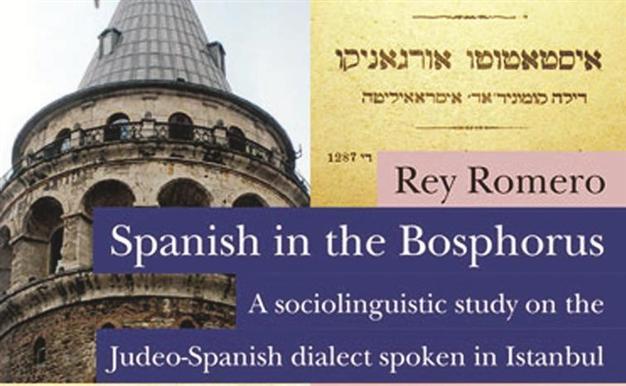Judeo-Spanish on the Bosphorus
William Armstrong - william.armstrong@hdn.com.tr
 ‘Spanish in the Bosphorus: A sociolinguistic study on the Judeo-Spanish dialect spoken in Istanbul’ by Rey Romero (Libra Kitap, pp 202, 50TL, 2012)
‘Spanish in the Bosphorus: A sociolinguistic study on the Judeo-Spanish dialect spoken in Istanbul’ by Rey Romero (Libra Kitap, pp 202, 50TL, 2012)There is a Sephardic proverb, saying, “Go where you are loved, and not from whence you are thrown out.” In 1492, the Jews of the Iberian Peninsula didn’t have much of a choice; forced out of the kingdoms of Castile and Aragon following the Catholic Reconquista, hundreds of thousands were dispersed across Europe, the Mediterranean, and North Africa, with large numbers migrating to Ottoman cities. Whether apocryphal or historical, the benevolence of Ottoman Sultan Beyazıt II has lived in Judeo-Spanish lore for centuries, having supposedly told his courtesans at the time: “You may think Ferdinand a very wise king. How can he be wise to have expelled such an industrious people to make me rich?” Rey Romero’s “Spanish in the Bosphorus” is a brief but lively account of the Judeo-Spanish language in the Ottoman Empire and the Turkish Republic, from its early flourishing to its critically endangered status today.
Whether or not the Sephardic Jews were “loved” in the empire, they were certainly seen by the Ottoman authorities as a valuable economic investment that could function as a much needed urban and merchant class. They soon established themselves as a distinct community within the Ottoman mosaic, without direct compulsion to abandon their language or religion, settling into their new home with astonishing speed and confidence. The high economic status of the Sephardim lent importance to Judeo-Spanish, which was used in all the community’s political, educational, economic, and religious domains, and was even learned by outsiders.
Throughout the book, Romero refers to the “Fishman Scale,” an eight-level scale used by linguists to measure language shift in endangered tongues. Shortly after settling in Ottoman territory, Judeo-Spanish was somewhere close to Level One, “the optimal scenario in which the endangered language occupies educational, professional, governmental, and media domains, although the group does not possess political independence.” Following this zenith, the story is one of a steady slide down the scale, from its early heyday to its current perilous position “somewhere between the eighth and sixth level.” In a sense, it was a victim of its own success. So intricately woven were the Sephardic Jews into the Ottoman Empire’s economic and social fabric that they were more affected than most when the empire began its slow deterioration in the 17th century. As the years passed, Sephardic professions gradually became limited to lower social spheres, and Turkish, Greek, Italian, and other European languages came to be associated with the economic and mercantile domains.
As the Ottomans made official moves toward Europe-inspired modernization in the 18th and 19th centuries, the Sephardim also began to look to Europe for their cultural and economic advancement, which further reinforced the increasingly low status of Judeo-Spanish. The French language became perceived as the gateway to modernity and social ascension, and it quickly became the language of the Jewish elite. Schools of the France-based “Alliance Israelite Universelle” were established, aiming to “civilize” and educate Levantine and Ottoman Jewry by imposing the “global” French language and culture. These Alliance schools spread rapidly across those Ottoman cities with major Jewish populations, and around a third of Jewish boys in Istanbul attended one by 1905, with a much higher percentage for girls. Of course, Judeo-Spanish was even further reduced to the home domain later on, following the “Turkification” campaigns that emerged after the Young Turk revolution in 1908, and even more aggressively after the establishment of the Turkish Republic in 1923.
Thus, after over a century-and-a-half of pro-French and pro-Turkish language policies, as well as a steady stream of Jewish emigrants leaving Turkey over the 20th century, it’s not surprising that Judeo-Spanish is now “struggling to survive.” In the past century, many languages and dialects have disappeared, with modernization and globalization having reduced linguistic diversity all over the world. Professional linguists have been predicting the death of Judeo-Spanish in Istanbul since the early 1900s, but countless new initiatives – which are briefly outlined at the end of this book – are now springing up in an effort to keep it alive. While globalization and standardization have seen hundreds of languages such as Judeo-Spanish squeezed out (or killed off), the very same process has also allowed individuals across the world to connect and organize in efforts to “save” their ancestral tongues, even if only out of a sense of nostalgia.
Notable recent release

‘From Anatolia to the New World - Life Stories of the First Turkish Immigrants to America’ by Rıfat N. Bali
(Libra Yayınevi, 70TL, pp 470)










